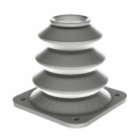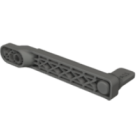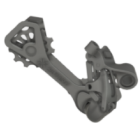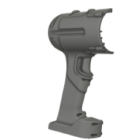Material Jetting
Among all additive manufacturing technologies, Material Jetting (MJ) stands out for its ability to deliver unmatched surface quality and geometric precision. Much like an inkjet printer — but working in three dimensions — this process builds parts by precisely depositing tiny droplets of photopolymer material, which are then cured with UV light. Often compared to Binder Jetting due to the naming similarity, Material Jetting is entirely distinct in both mechanism and use case. It’s a go-to method when visual appearance and dimensional accuracy are non-negotiable.
What is Material Jetting?
Material Jetting is an additive manufacturing process in which droplets of build material — usually liquid photopolymers — are deposited onto a build platform through multiple printheads. These droplets are immediately cured (solidified) using ultraviolet (UV) light, allowing the printer to create solid objects layer by layer.
Multiple printheads can dispense different materials simultaneously, enabling multi-material and full-color printing within a single job. This makes MJ unique among 3D printing methods, especially when there’s a need for high-fidelity prototyping or detailed visual models.
How Material Jetting works
The process starts with a thin layer of material jetted onto the build plate. Each droplet is immediately cured by a UV lamp traveling alongside the printhead. Once a layer is complete, the build platform lowers by a fraction of a millimeter, and the next layer begins.
The materials used in Material Jetting are typically stored in cartridges and maintained at optimal temperatures to ensure proper viscosity and jetting behavior. Parts are printed with fine resolution — often with layer heights as low as 16 microns — resulting in extremely smooth surfaces and crisp details.
Key applications of Material Jetting
Material Jetting is primarily used in areas where visual realism and precision are critical. Its applications include:
- product design and concept modeling,
- dental and medical modeling,
- jewelry prototyping,
- color prototypes for consumer electronics or packaging,
- microfluidics and tiny assemblies requiring tolerances under 0.1 mm.
In short, it’s not a method for functional parts under mechanical stress, but it’s ideal for form validation, presentation, and pre-manufacturing approvals.
Available materials
Material Jetting relies on photopolymers, waxes, and elastomeric resins that can be jetted in liquid form and cured quickly. These include:
- rigid opaque resins (simulating ABS or PP in appearance),
- transparent resins (for visualizing internal features),
- flexible rubber-like materials (for seals or tactile prototypes),
- casting waxes (for investment casting in jewelry or dentistry),
- color resins (enabling CMYK-based full-color prints).
Although mechanically weaker than engineering thermoplastics, these materials offer superb detail and surface finish.
Advantages and disadvantages of Material Jetting
Advantages
| Disadvantages
|
Material Jetting vs material extrusion (FDM)
Material Jetting and Material Extrusion (e.g., FDM) differ fundamentally in both mechanism and use case. While FDM pushes solid filament through a heated nozzle, MJ sprays micro-droplets of liquid that are instantly cured. The result is much higher resolution and a smoother finish in MJ, but at the cost of strength, durability, and material variety.
Where FDM is used for functional testing and durable parts, MJ is preferred for aesthetic evaluation, color testing, and intricate geometries that demand visual accuracy.
Summary
Material Jetting is the most precise and visually capable 3D printing technology currently available, making it indispensable in industries that require visual validation or multi-material, multi-color printing. While it isn’t the strongest or most cost-effective solution for functional parts, its strengths lie in presentation, design validation, and surface realism. In the right hands, MJ becomes a powerful tool for reducing development time, improving client communication, and accelerating the decision-making process — all while delivering prints that look remarkably like the final product.
Explore also
- Overview of 3D printing tech
- What is SLS printing?
- What is FDM 3D printing?
- What is SLA 3D printing?
- MJF 3D printing
- DLP 3D printing
- What is DMLS and SLM 3D printing?
- Binder Jetting
- PolyJet printing
- New 3D printing technology
- 3D print vs injection molding
Related categories













